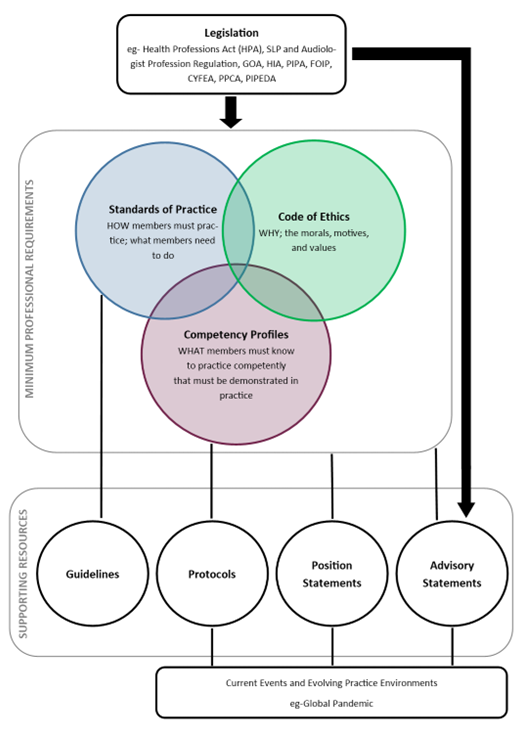
The minimum requirements for SLPs’ and audiologists’ professional practice are defined in three key documents:
| Code of Ethics | Standards of Practice | Competency profiles |
|---|---|---|
|
|
|
These documents set out the minimum requirements against which a practitioner’s conduct (i.e., professional behaviour) is measured. A breach of the minimum requirements as outlined in these documents may constitute unprofessional conduct (as defined in the HPA). All requirements set out in these three documents are applicable to all regulated members, regardless of their practice setting, or whether they provide clinical or non-clinical services.
Code of Ethics
The ACSLPA Code of Ethics (the Code) outlines the ethical principles, values, and responsibilities to which regulated members must adhere. Regulated members must practice in accordance with the Code.
The Code:
- Provides a reference for regulated members to guide them in ethical behavior and decision making,
- Serves as a tool for evaluating ethical behavior and as a legal reference for professional conduct, and
- Outlines to the public what they can expect in terms of ethical practice from SLPs and Audiologists in Alberta.
Standards of Practice
The Standards of Practice (i.e. the Standards) are the established measures or norms which define the minimum level of professional performance that regulated members must demonstrate in their practice.
The Standards are updated on a regular basis to reflect changing practice needs and trends. Each regulated member of ACSLPA is accountable for practicing in accordance with the Standards, regardless of role, practice area, or practice setting
Speech-Language Pathology and Audiology Competency Profiles
Each profession’s Competency Profile states the minimum knowledge and skills required for entry to practice as an SLP or Audiologist. The profiles were developed as part of a national project, using language common to healthcare providers to better support interprofessional collaboration. The profiles are evidence-based, needs-driven, and outcome measured.
ACSLPA uses the Competency Profiles in its registration, continuing competence, and professional conduct functions. The profile is based on the seven roles required of SLPs and Audiologists (shown below), which are broken down further into essential competencies and sub-competencies.
Advisory Statements, Guidelines, Position Statements, and Protocols
As discussed in Module 1, the College has also made available a number of supporting documents, developed to support the professional practice of regulated members. Their relationship to the Code of Ethics, Standards of Practice, and Competency Profiles is shown below (see Module 1 or ACSLPA website, for more). New documents are developed, as needed, to address issues relevant to regulated members. Each regulated member is responsible for staying informed regarding new directives and practicing in compliance with these documents.



